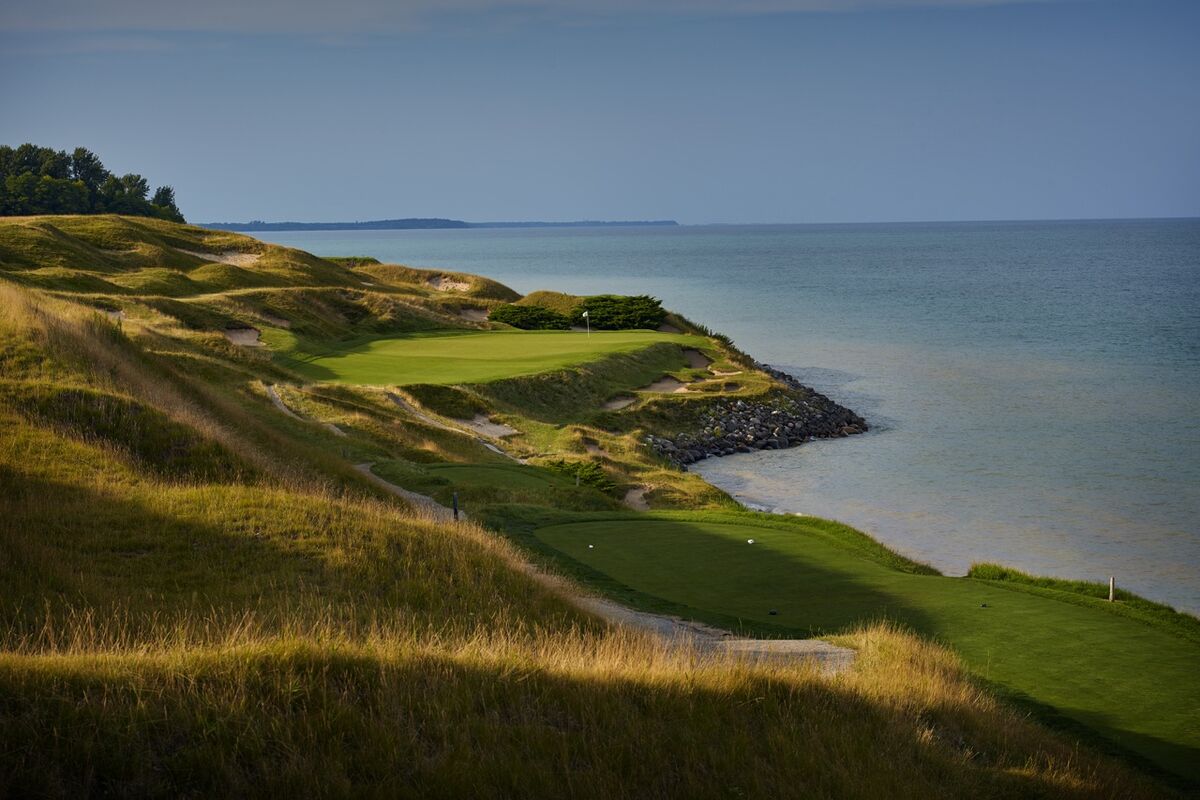Whistling Straits: Profile of a Prestigious, Inspired Golf Course

Throw out everything you picture in typical prestigious American golf courses and replace it with rugged terrain, captivating seaside views and the charm of the Irish countryside. Whistling Straits is a 36-hole Pete Dye masterpiece found along the shores of Lake Michigan in Sheboygan, Wisconsin. Perhaps just as remarkable? Whistling Straits is open to the public.
The Courses of Whistling Straits
Once an anti-aircraft training base, Whistling Straits was crafted by Dye along two miles of Lake Michigan’s shoreline and opened in 1998. Whistling Straits is comprised of two courses – the Straits Course and the Irish Course. Each hole on both courses has its own creative name, like Last Gaspe and Gremlin’s Ear.
The Irish Course features your choice of six tees with the par-72 championship tees measuring 7,201 yards. Four streams meander through the Irish Course and team with hundreds of bunkers and dunes to form a tranquil, yet challenging layout. The No. 1 handicap hole is the long 479-yard par-4 15th hole known as Frog Water. Pot bunkers surround the long, thin green. Most golfers play it safe on the left side of the dogleg right hole, making it even longer from tee to green.
While the Irish Course is special in its own right, the Straits Course is Whistling Strait’s flagship layout. The 7,790-yard, par-72 gem is as challenging as it is stunning with a course rating of 77.2 and a slope of 152 from the championship tees. The Straits Course has hosted four major tournaments and is the home of the Ryder Cup 2020, which will be played September 24th through the 26th. Whistling Straits is the first public golf course to host the Ryder Cup in nearly a quarter of a century.
The Straits Course at Whistling Straits
Year after year, the Straits Course is ranked one the top 10 public golf courses in America. The open design has a links-style look with very few trees, undulating mounds, an abundance of sand and postcard-worthy views of Lake Michigan. One thing missing from the course – cart paths. The Straits Course (as well as the Irish Course) is walking-only, which just adds to its charm.
The course is adjacent to the lake so wind and temperature shifts can be drastic and have a major effect on each shot.
Since natural landscape is prevalent at Whistling Straits, each hole on the Straits Course provides a unique experience. Take a look at the three top handicap holes:
No. 8 “On the Rocks”
This No. 3 handicap hole is a monstrous par-4 at 506 yards. The most daunting part of the hole is the 100-plus bunkers, the most troublesome being a deep pot bunker found behind the green.
No. 18 “Dyeabolical”
This par-4, 520-yard finishing hole is the perfect combination of beauty and beast. The No. 2 handicap hole is split by Seven Mile Creek that runs through the fairway and along the left side of the green. The downhill approach is often affected by swirling winds so choose your club to the green wisely.
No. 4 “Glory”
One look off the tee and you won’t be fooled by this hole’s sweet name. The Strait’s No. 1 handicap hole is a 494-yard par-4 that is protected by dunes and bunkers on the right and more bunkers and Lake Michigan on the left.
Tournaments at Whistling Straits
In addition to this year’s Ryder Cup, several major tournaments have been held at Straits Course at Whistling Straits, including the 2004, 2010 and 2015 PGA Championships as well as the 2007 U.S. Senior Open.
Is Whistling Straits Really Open to the Public?
Unlike most tournament-type courses, Whistling Straits is open to the public. As is the case with other prestigious public clubs, Whistling Straits is not cheap to play. For example, the greens fee for one golfer on a Wednesday morning in June at the Straits Course is $440. Twilight rates are a bit lower, but since carts are not permitted, you’ll want to factor in an additional $100 for caddie fee and tip.
Golfers in groups under eight can book directly on Whistling Straits website.
Image: Gary Kellner/PGA of America via Getty Images